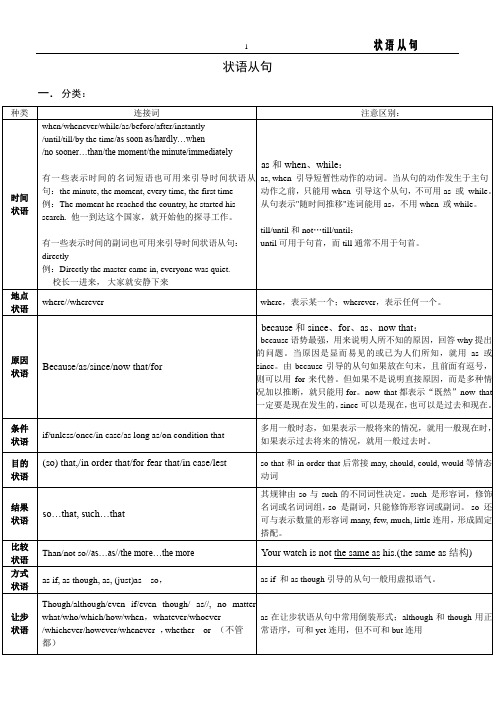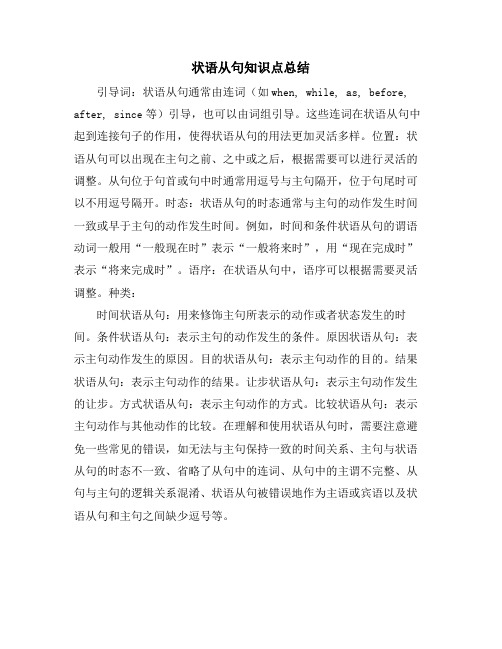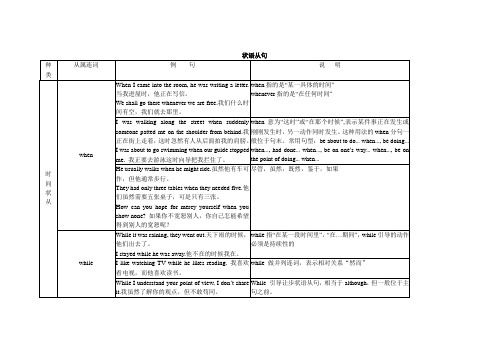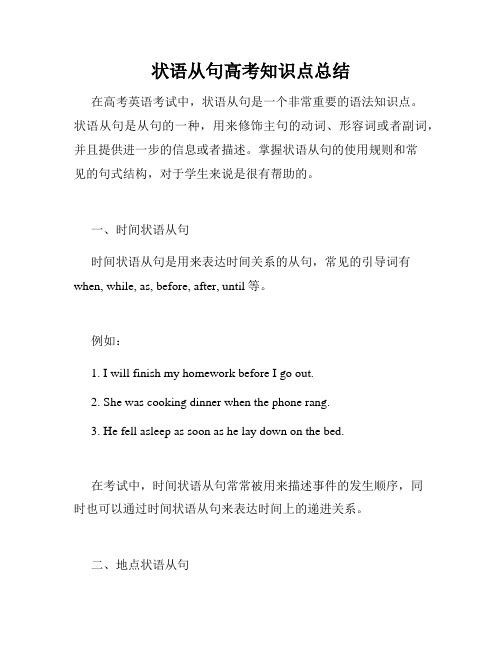(新)高考英语语法知识点归纳总结:状语从句(1)
(完整版)状语从句知识点大全

(完整版)状语从句知识点大全状语从句是一个句子做另一个句子的状语,用于描述、限制、补充或解释主句的动作或状态。
在英语语法中,状语从句非常常见且广泛应用。
以下是状语从句的一些常见知识点:1. 时间状语从句(Time Adverbial Clauses):用来表示时间,常用的引导词有when, while, as, before, after, until, since等。
例如:I will call you when I arrive home.翻译:我到家时会打电话给你。
2. 地点状语从句(Place Adverbial Clauses):用来表示地点,常用的引导词有where, wherever等。
例如:She can't find her keys anywhere.翻译:她无论到哪儿都找不到她的钥匙。
3. 原因状语从句(Cause Adverbial Clauses):用来表示原因,常用的引导词有because, since, as, for等。
例如:I didn't go to the party because I was tired.翻译:因为我累了,所以我没有去参加聚会。
4. 结果状语从句(Result Adverbial Clauses):用来表示结果,常用的引导词有so, therefore, thus等。
例如:He studied hard, so he passed the exam.翻译:他努力研究,所以他通过了考试。
5. 条件状语从句(Condition Adverbial Clauses):用来表示条件,常用的引导词有if, unless, provided that等。
例如:If it rains tomorrow, we won't go to the park.翻译:如果明天下雨,我们不会去公园。
6. 目的状语从句(Purpose Adverbial Clauses):用来表示目的,常用的引导词有so that, in order that等。
状语从句知识点大总结

状语从句知识点大总结一、状语从句的定义状语从句是一个句子,它在句子中作状语,修饰主句中的动词、形容词、副词等,用以表示时间、条件、原因、目的、结果、比较等不同的状态。
状语从句通常由连词引导,常用的连词包括when, while, as, since, before, after, until, if, unless, although, though, as if, as though, so that, in order that, in case, even if等。
二、状语从句的分类1. 时间状语从句时间状语从句表示动作发生的时间,常用的引导词有when, while, as, before, after, since, until, as soon as等。
例如:- When I was young, I used to go swimming every day.- I will call you as soon as I arrive.2. 条件状语从句条件状语从句表示条件,常用的引导词有if, unless, provided that, as long as等。
例如:- If it rains tomorrow, we will stay at home.- I will go out unless it is raining.3. 原因状语从句原因状语从句表示原因,常用的引导词有because, since, as, for等。
例如:- Since it is raining, we can't go out.- I won't go to the party because I don't feel well.4. 目的状语从句目的状语从句表示目的,常用的引导词有so that, in order that, lest等。
例如:- I study hard so that I can get a good job.- We left early in order that we might avoid the traffic.5. 结果状语从句结果状语从句表示结果,常用的引导词有so...that, such...that等。
完整版)高中状语从句归纳

完整版)高中状语从句归纳状语从句是在句子中做状语的,包括时间、条件、让步、原因、目的、结果、比较、地点、方式状语从句。
时间状语从句可以由when、as、while、until、not…until、before、after、since、the minute、the moment、each (every。
next。
the first) time等引导。
在时间状语从句中,一般使用一般现在时或一般过去时来表达。
1.时间状语从句引导词当句子中有时间状语从句时,可以用when、as、while、until、not…until、before、after、since、the minute、the moment、each (every。
next。
the first) time等来引导。
这些引导词在句子中的使用有不同的侧重点和用法。
1.1 when当我们用when引导时间状语从句时,它的主语和主句的主语相同。
如果从句的谓语动词是be动词,那么从句的主语和be可以省略。
例如:When I arrived home。
I had a little rest.1.2 asas不仅可以表示“当。
的时候”,还可以表示“一面。
一面”和“随着”的意思。
例如:XXX(一面。
一面)You will XXX(随着)1.3 whileXXX表示“当。
的时候”,强调主句的动作和从句的动作同时发生。
从句一般使用进行时,动词必须是延续性动词。
例如:While we were working。
they were having a rest.While they were having a n。
they got very confused.注意:while也有对比的含义,可以解释为“然而”。
例如:XXX。
XXX.2.until和not。
untiluntil和not。
until都表示“直到。
才”。
在肯定句中,主句常用延续性动词;在否定句中,主句常用短暂性动词。
高考状语从句知识点

高考状语从句知识点状语从句是高考英语中的一个重要知识点,掌握好它对于我们在高考中取得好成绩可是相当关键哦!今天咱们就来好好聊聊状语从句。
先来说说啥是状语从句。
简单来讲,状语从句就是用一个句子来充当状语。
那啥是状语呢?就好比咱们跑步的时候,给你加油打气的那些话,告诉你跑快一点、跑慢一点、往这边跑、往那边跑,这些起辅助说明作用的就是状语。
而用一个句子来做这个辅助说明的工作,那就是状语从句啦。
状语从句的种类那可不少,有时间状语从句、地点状语从句、原因状语从句、条件状语从句、目的状语从句、结果状语从句、让步状语从句、比较状语从句和方式状语从句等等。
咱们先来说说时间状语从句。
比如说“When I was a child, I often played in the park” 这里的“When I was a child”就是一个时间状语从句,表示“当我还是个孩子的时候”。
再比如“While I was doing my homework, my mom was cooking dinner” 这里的“While I was doing my homework”表示“当我正在做作业的时候”。
记得我以前教过一个学生,叫小李。
有一次考试,他就因为时间状语从句丢了不少分。
那次考试有一道题是这样的:“______ he came in, I was reading a book” 选项有“When、While、As”。
这小李啊,想都没想就选了“While”,结果就错啦。
后来我给他分析,这题应该选“When”,因为“While”强调的是动作的同时进行,而这里“came in”是一个短暂性动作,“reading a book”是一个持续性动作,所以要用“When”。
从那以后,小李可长记性了,每次遇到时间状语从句的题都会仔细分析。
接下来是地点状语从句。
像“Where there is a will, there is a way” 意思就是“有志者,事竟成”,这里的“Where there is a will”就是地点状语从句,表示“有意志的地方”。
(完整版)高中英语语法-状语从句归纳总结

状语从句一.分类:when (当……的时候) while (在……期间) as (当……的时候, 一边……一边……)before (在……之前) since (自从……以来) till/until (直到) hardly…when… (刚……就) as soon as (一……就……)after (在……之后) not…till/until(直到……才)no sooner…than…(刚……就) 地点状语从句:where (在那里) wherever(无论哪里)原因状语从句:because (因为) since (因为,既然) as (由于) for (为了) now that(既然)目的状语从句:(so)that=in order that(以便)so as(not)to (以便[不])in case(以免)lest(以免)结果状语从句:so+adj./adv.+that(如此……以致)so that(结果……)such+n.+that(如果……以致)that(所以,因此)让步状语从句:though/although不可同but连用。
though/although (虽然)however (可是)even though/if(即使)no matter+what/which/where/who/when =whatever/whichever/wherever/whoever/whenever(不论什么/哪一个/哪里/谁/何时)比较状语从句:as (正如)as…as(和……一样)not as/so … as (不如……)than(比……更)the+比较级…+the+比较级(越……越……)条件状语从句:if(假设)unless(如果不)so long as(只要)on condition that (如果)方式状语从句:as(像……那样地)just as(正像)as if(好像)as though(好像)二.各种状语从句的简化方法:1作状语。
状语从句知识点总结

状语从句知识点总结
引导词:状语从句通常由连词(如when, while, as, before, after, since等)引导,也可以由词组引导。
这些连词在状语从句中起到连接句子的作用,使得状语从句的用法更加灵活多样。
位置:状语从句可以出现在主句之前、之中或之后,根据需要可以进行灵活的调整。
从句位于句首或句中时通常用逗号与主句隔开,位于句尾时可以不用逗号隔开。
时态:状语从句的时态通常与主句的动作发生时间一致或早于主句的动作发生时间。
例如,时间和条件状语从句的谓语动词一般用“一般现在时”表示“一般将来时”,用“现在完成时”表示“将来完成时”。
语序:在状语从句中,语序可以根据需要灵活调整。
种类:
时间状语从句:用来修饰主句所表示的动作或者状态发生的时间。
条件状语从句:表示主句的动作发生的条件。
原因状语从句:表示主句动作发生的原因。
目的状语从句:表示主句动作的目的。
结果状语从句:表示主句动作的结果。
让步状语从句:表示主句动作发生的让步。
方式状语从句:表示主句动作的方式。
比较状语从句:表示主句动作与其他动作的比较。
在理解和使用状语从句时,需要注意避免一些常见的错误,如无法与主句保持一致的时间关系、主句与状语从句的时态不一致、省略了从句中的连词、从句中的主谓不完整、从句与主句的逻辑关系混淆、状语从句被错误地作为主语或宾语以及状语从句和主句之间缺少逗号等。
总之,状语从句的使用可以丰富句子的结构,使文章更加丰富多样。
掌握状语从句的引导词、位置、时态、语序以及种类等知识点,对于提高英语写作能力具有重要意义。
高考英语语法知识点归纳总结:状语从句

只要有生命,就有希望。
While引导条件状语从句,相当于as/so long as,翻译成“只要”
as
He hurried home, looking behind as he went.
他赶快回家,不时地一边走一边向后看。
as引导持续性动作,强调主句和从句的动作同时发生
AsIget older,Iget more optimistic.
C.“还没有……”“免得”“不知不觉”“宁可、宁愿”“否则,要不然”
It will be five years before he returns to his homeland.再过五年他才能回国。
It won’t be long before we meet again.过不了多久我们就会再见面的。
si放句首
for
He must be ill, for he is absent today.他一定是病了,因为他今天没有来。
不是说明直接原因,而是对某种情况加以推断,用于表示补充说明理由。
as
As he didn’t know much English, he looked up the word in the dictionary.
状语从句高考知识点总结

状语从句高考知识点总结在高考英语考试中,状语从句是一个非常重要的语法知识点。
状语从句是从句的一种,用来修饰主句的动词、形容词或者副词,并且提供进一步的信息或者描述。
掌握状语从句的使用规则和常见的句式结构,对于学生来说是很有帮助的。
一、时间状语从句时间状语从句是用来表达时间关系的从句,常见的引导词有when, while, as, before, after, until等。
例如:1. I will finish my homework before I go out.2. She was cooking dinner when the phone rang.3. He fell asleep as soon as he lay down on the bed.在考试中,时间状语从句常常被用来描述事件的发生顺序,同时也可以通过时间状语从句来表达时间上的递进关系。
二、地点状语从句地点状语从句是用来表示事件发生的地点的从句,常见的引导词有where, wherever等。
例如:1. I will follow you wherever you go.2. She looked around, trying to find out where the noise was coming from.在高考中,地点状语从句可以用来描述人们在不同的场所进行各种活动,增强语言表达的准确性和丰富性。
三、原因状语从句原因状语从句是用来表示某个事件的原因或者理由的从句,常见的引导词有because, since, as, for等。
例如:1. He couldn't come to the party because he was busy with his work.2. Since it's raining outside, we can't have a picnic in the park.高考中,原因状语从句常常被使用在写作文的时候,可以帮助学生更好地陈述事实和论证观点。
- 1、下载文档前请自行甄别文档内容的完整性,平台不提供额外的编辑、内容补充、找答案等附加服务。
- 2、"仅部分预览"的文档,不可在线预览部分如存在完整性等问题,可反馈申请退款(可完整预览的文档不适用该条件!)。
- 3、如文档侵犯您的权益,请联系客服反馈,我们会尽快为您处理(人工客服工作时间:9:00-18:30)。
As he was going out, it began to rain.
强调两个动作紧接着发生。
As a boy(When he was a boy), he was hopeless at maths.
as+名词,相当于时间状语从句
before
A.Be a pupil before you become a teacher.
Great changes have taken place in China since 1978.
As soon as I arrive in Shanghai, I’ll write to you.
状语从句在主句之前时一般用逗号与主句分开,如从句在主句之后则不必用标点符号。
Mr. Li has been here since he came back.
WhileIunderstand your point of view,Idon’t share it.
While引导让步状语从句,相当于although,但一般位于主句之前。
While there is life, there is hope.
While引导条件状语从句,相当于as/so long as,翻译成“只要”
as
He hurried home, looking behind as he went.
as引导持续性动作,强调主句和从句的动作同时发生
AsIget older,Iget more optimistic.
两种正在发展或变化的情况,有“随着”的意思,表时间的推移。
He hurried home, looking behind as he went.
B“还没有……”“免得”“不知不觉”“宁可、宁愿”“否则,要不然”
It will be five years before he returns to his homeland.
It won’t be long before we meet again.
状语从句
种类
从属连词
例句
说明
时
间
状
从
when
When I came into the room, he was writing a letter.
We shall go there whenever we are free.
when指的是“某一具体的时间”
whenever指的是“在任何时间”
I was walking along the street when suddenly someone patted me on the shoulder from behind.
It+(not)be+some time+before从句。肯定句中,“多长时间之后才”;否定句中,“用不了多长时间就”
after
He arrived after the game started.
until/till
We waited till (until)he came back .
如主句动词是持续性动作,常用肯定式,表示“直到…为止”
She didn’t stop working until eleven o’clock .
Until he had passed out of sight, she stood there.
如主句动词是瞬间动词,常用否定式,表示“直…才”“在…以前不”,从句放在句首表示强调,一般用until
since
Iwas about to go swimming when our guide stopped me.
when意为“这时”或“在那个时候”,表示某件事正在发生或刚刚发生时,另一动作同时发生。这种用法的when分句一般位于句末。常用句型:be about to do…when…, be doing…when…, had done…when…, be on one’s way…when…, be on the point of doing…when…
Leave me beforeIchanged my mind.
I’d die beforeIapologized to them.
Get out beforeIcall the police.
往往表示主句的动作先于从句的动作发生,“在……之前”,
A.“……才”(强调主句所表达的时间、举例很长或花费的力气很大。)
He usually walks when he might ride.They had only three tables when they needed five.
How can you hope for mercy yourself when you show none?
尽管,虽然,既然,鉴于,如果
Ihave written home but once sinceIcame here.
since后是非延续性动词的过去式,则时间的起点应从该动作发生时算起。
He has written to me frequently since he was ill.
since后是延续性动词的过去式,则时间的起点应从该动作结束时算起。
It is (has been) a long time sinceIsmoked.
It has been two years sinceIbegan to smoke.
while
While it was raining, they went out.
I stayed while he was away.
while指“在某一段时间里”,“在…期间”,while引导的动作必须是持续性的
Ilike watching TV while he likes reading.
while做并列连词,表示相对关系“然而”
BWe waited a long time before he came out
.We hadn’t waited long before he came out.
C.He died before he wrote a will.
D.he sun had set before we knew it.
